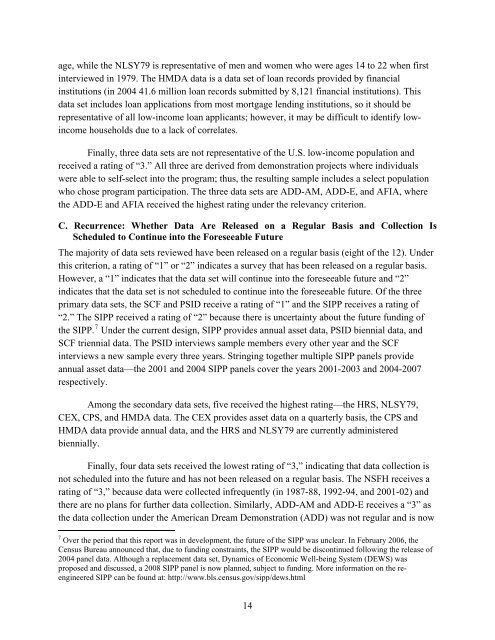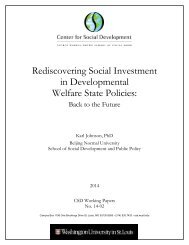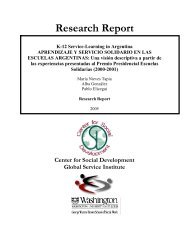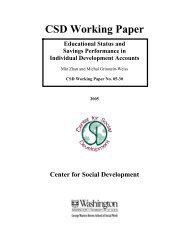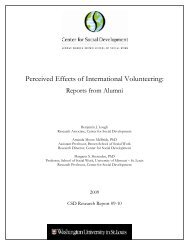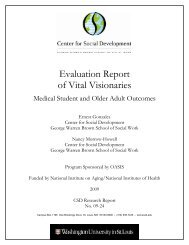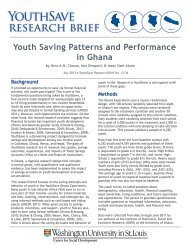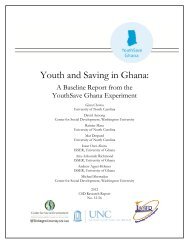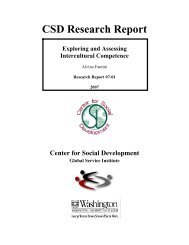Assessing Asset Data on Low-Income Households - Urban Institute
Assessing Asset Data on Low-Income Households - Urban Institute
Assessing Asset Data on Low-Income Households - Urban Institute
You also want an ePaper? Increase the reach of your titles
YUMPU automatically turns print PDFs into web optimized ePapers that Google loves.
age, while the NLSY79 is representative of men and women who were ages 14 to 22 when first<br />
interviewed in 1979. The HMDA data is a data set of loan records provided by financial<br />
instituti<strong>on</strong>s (in 2004 41.6 milli<strong>on</strong> loan records submitted by 8,121 financial instituti<strong>on</strong>s). This<br />
data set includes loan applicati<strong>on</strong>s from most mortgage lending instituti<strong>on</strong>s, so it should be<br />
representative of all low-income loan applicants; however, it may be difficult to identify lowincome<br />
households due to a lack of correlates.<br />
Finally, three data sets are not representative of the U.S. low-income populati<strong>on</strong> and<br />
received a rating of “3.” All three are derived from dem<strong>on</strong>strati<strong>on</strong> projects where individuals<br />
were able to self-select into the program; thus, the resulting sample includes a select populati<strong>on</strong><br />
who chose program participati<strong>on</strong>. The three data sets are ADD-AM, ADD-E, and AFIA, where<br />
the ADD-E and AFIA received the highest rating under the relevancy criteri<strong>on</strong>.<br />
C. Recurrence: Whether <str<strong>on</strong>g>Data</str<strong>on</strong>g> Are Released <strong>on</strong> a Regular Basis and Collecti<strong>on</strong> Is<br />
Scheduled to C<strong>on</strong>tinue into the Foreseeable Future<br />
The majority of data sets reviewed have been released <strong>on</strong> a regular basis (eight of the 12). Under<br />
this criteri<strong>on</strong>, a rating of “1” or “2” indicates a survey that has been released <strong>on</strong> a regular basis.<br />
However, a “1” indicates that the data set will c<strong>on</strong>tinue into the foreseeable future and “2”<br />
indicates that the data set is not scheduled to c<strong>on</strong>tinue into the foreseeable future. Of the three<br />
primary data sets, the SCF and PSID receive a rating of “1” and the SIPP receives a rating of<br />
“2.” The SIPP received a rating of “2” because there is uncertainty about the future funding of<br />
the SIPP. 7 Under the current design, SIPP provides annual asset data, PSID biennial data, and<br />
SCF triennial data. The PSID interviews sample members every other year and the SCF<br />
interviews a new sample every three years. Stringing together multiple SIPP panels provide<br />
annual asset data—the 2001 and 2004 SIPP panels cover the years 2001-2003 and 2004-2007<br />
respectively.<br />
Am<strong>on</strong>g the sec<strong>on</strong>dary data sets, five received the highest rating—the HRS, NLSY79,<br />
CEX, CPS, and HMDA data. The CEX provides asset data <strong>on</strong> a quarterly basis, the CPS and<br />
HMDA data provide annual data, and the HRS and NLSY79 are currently administered<br />
biennially.<br />
Finally, four data sets received the lowest rating of “3,” indicating that data collecti<strong>on</strong> is<br />
not scheduled into the future and has not been released <strong>on</strong> a regular basis. The NSFH receives a<br />
rating of “3,” because data were collected infrequently (in 1987-88, 1992-94, and 2001-02) and<br />
there are no plans for further data collecti<strong>on</strong>. Similarly, ADD-AM and ADD-E receives a “3” as<br />
the data collecti<strong>on</strong> under the American Dream Dem<strong>on</strong>strati<strong>on</strong> (ADD) was not regular and is now<br />
7 Over the period that this report was in development, the future of the SIPP was unclear. In February 2006, the<br />
Census Bureau announced that, due to funding c<strong>on</strong>straints, the SIPP would be disc<strong>on</strong>tinued following the release of<br />
2004 panel data. Although a replacement data set, Dynamics of Ec<strong>on</strong>omic Well-being System (DEWS) was<br />
proposed and discussed, a 2008 SIPP panel is now planned, subject to funding. More informati<strong>on</strong> <strong>on</strong> the reengineered<br />
SIPP can be found at: http://www.bls.census.gov/sipp/dews.html<br />
14


